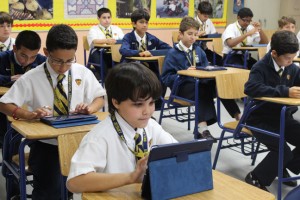For more than two years, administrators at Purcell Marian High School in Cincinnati have been navigating the competing pressures of new and old.
They decided the shift to blended learning could help them meet the varying needs of an increasingly diverse student body, and help their students meet a state requirement to pass four years of high school math courses. They also knew that they couldn’t knock down all the walls in their 87-year-old building or upend the traditions that had drawn students to seek a Catholic education in the first place.

“We couldn’t just gut the school and start over as an all-blended learning school,” Jeanine Flick, the school’s academic dean, told a crowded session at an Orlando conference for thousands of Catholic educators.
Instead, in 2013 the school began a gradual, subject-by-subject shift from paper textbooks to electronic ones, and from instruction led entirely by teachers to what principal Veronica Murphy described as a more “student-centered” approach, in which students work through material based on what they have mastered. It began converting one of its newer buildings into an open-plan “blended learning center.”
While Catholic educators, much like their public-school counterparts, have been exploring blended learning for a few years, it’s now becoming widespread, and was one of the hottest topics at the National Catholic Educational Association’s annual convention last week. Sessions were often packed with teachers and administrators looking to draw lessons from schools like Purcell Marian that have already made the shift and are starting to draw lessons from it.
They’ve faced many of the same the same hurdles as public schools, and some unique ones. For one thing, they often lack public funding to pay for students’ devices or the technology that connects them.
Francisco Castillo-Fierro, the Director of Blended Learning at Cristo Rey San Jose Jesuit High School, has written about the challenges of setting up a school’s technology infrastructure. He said during one session that blended learning has helped free students from the strictures of seat time, allowing his school to accommodate the Cristo Rey network’s signature work-study program, which takes students out of the classroom one day a week.
Being in Silicon Valley meant his school had access to supporters at companies like Cisco Systems, who helped arrange deals for wireless access points and other costly equipment.
“Those things are not cheap,” he said.
Monsignor Edward Pace High School was one of the first schools in the Archdiocese of Miami to place an iPad in the hands of every student. Ana Garcia, its principal, said the one-to-one initiative didn’t break the school’s budget. It shifted funds that would have paid for textbooks toward digital curricula and wireless infrastructure. The state of Florida is requiring public schools to make a similar shift in the way they use state funding for instructional materials.
Pace also required students to supply their own iPads. This helped the school avoid a budget crunch, but it created a potential hardship for some families.
The school overcame that problem with the help of a $20,000 donation that allowed it to subsidize tablets for families who couldn’t readily afford them. It used the money to cover half the cost of those students’ devices, and had families defray the remaining cost with monthly payment plans. Since students own their devices, they have an incentive to care for them.
Three years in, Garcia said the digital conversion has been worth it. Teachers can now draw on materials available from the Web or iTunes U to supplement their electronic textbooks. As a result, they’re constantly updating and improving their lessons. And students actively seek supplemental information on their own.
Teachers are no longer the sole disseminators of information, and have become facilitators who help students take control of their learning — and think critically about the information they find, a skill Garcia said they will need after they graduate.
“We have to prepare the kids for that world, that will be ever-changing, ever-growing, more technological,” she said.
As one of the digital pioneers among South Florida Catholic schools, Pace now assists other schools in the Archdiocese that are beginning blended learning pushes of their own.
“When I think of what we accomplished, it was way less difficult than we thought, because the teachers were willing … and the kids were awesome,” Garcia said.


